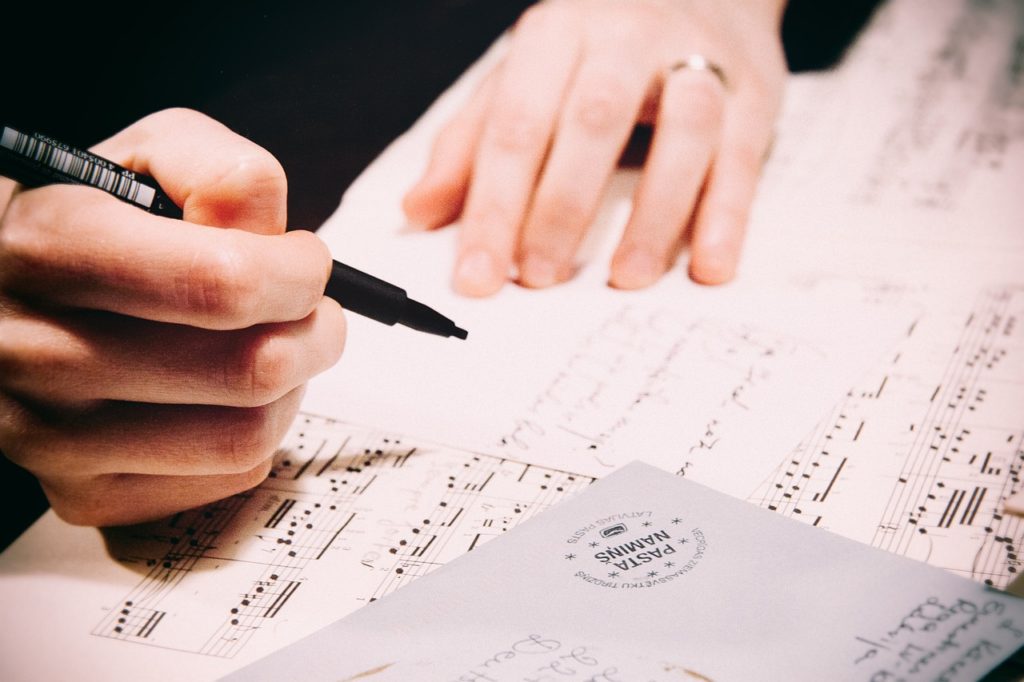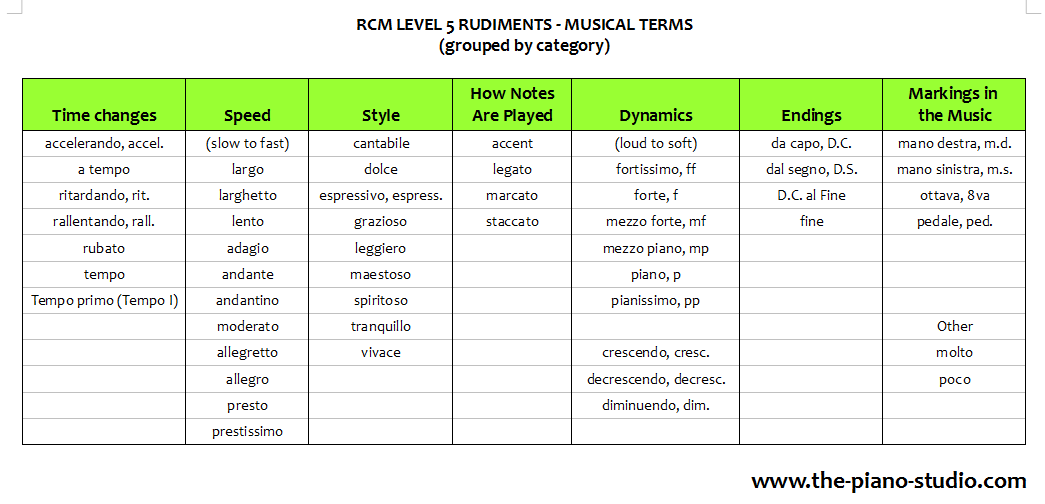RCM Level 5 Theory – Study Helps
The RCM Level 5 Theory exam is a theory paper that goes with Level 5 Practical Piano. In order to receive your certificate, the written paper needs to be completed within 5 years of playing your Grade 5 piano exam (there is no time limit if you do the theory first). The Level 5 Theory exam is about elements of music notation for the beginner and lasts one hour long.
These study helps are based on the 2016 Theory Syllabus.
Topics that are covered include Pitch and Notation, Rhythm and Meter, Intervals, Scales, Chords and Harmony, Melody and Composition, Form and Analysis, and Musical Terms and Signs.

Study helps for your Level 5 exam
Pitch and Notation
- when asked to identify notes, be very careful to notice which clef you are reading in, and any notes that are affected by key signatures and/or accidentals
- when transposing short melodies up or down one octave, be careful to have the correct clef. If you write out your transposition directly under the given melody, it will be easier to check for errors
- Make sure your finished transposition includes details like note values, time signatures, key signatures, and phrasing. Make sure stems are pointing in the correct direction. (Any note above the middle line of the staff: the stems go down and on the left; any note below the middle line of the staff: the stems go up and on the right. Any on the middle line of the staff can go in either direction.
Rhythm and Meter
- read carefully whether the question asks you to fill in notes or rests
- anacrusis (upbeats) are partial bars at the beginning of bars. The rest of the partial bar is found at the end of the piece.
- Don’t join beats two and three
- Complete partial beats and make sure your completed bars add up to the required time signature
Intervals
- Remember that perfect intervals are 1, 4, 5, and 8
- 2, 3, 6, and 7 can be major or minor
- Figure out the number first, find the key signature that goes with the bottom note, If the upper note is part of the major scale, the interval is major OR perfect. If it is a half step smaller, then the interval is minor.
- Half-steps have two types: chromatic and diatonic. (Chromatic half-steps have the same letter names, e.g. C & C#; Diatonic half-steps have different letter names. Think: DIatonic = DIfferent, e.g. C & Db)
Scales
- Read the questions carefully, and underline important words to make sure you complete the questions properly (which clef, what kind of notes, which form of the minor scale, key signature or accidentals, ascending or descending etc.)
- Know what alterations you need for each form of the minor scale. (Natural – same key signature as the relative major; Harmonic – raise the seventh note ascending and descending; Melodic – raise the sixth and seventh note ascending and lower them on the way down.)
- Tonic, Subdominant, and Dominant refer to the I, IV, and V steps of the scale, respectively
- Know the difference between Leading tone (raised 7th, a half-step below the tonic in a minor scale) and subtonic (regular 7th, a whole step below the tonic)
- To find the relative minor, go down three half steps (not including the starting note). e.g. the relative minor of C is A (C start, down to B, down to Bb, land on A).
- Know that parallel major and minor keys share the same tonic
Chords and Harmony
- Remember the raised 7th note in the harmonic minor scale: it affects the V (dominant) chord
- Read what the question asks for carefully: what scale step to start on (tonic, subdominant, or dominant), what inversion is asked for (root position, 1st inversion, 2nd inversion), what type (solid/blocked or broken form)
- The difference between functional chord symbols (I, i, IV, iv, V, V⁷) and root/quality chord symbols (C, Am, G7)
Melody and Composition
- A parallel period is an 8 measure phrase, consisting of a 4 measure question (antecedent) and a 4 measure answer (consequent).
- Stable scale degrees should be at the end of the consequent phrase while antecedent phrases end on unstable scale degrees
Form and Analysis
- When trying to figure out the key, check the major and minor version of the key signature, look at the beginning note and the ending note. Usually at least one of these will be the tonic of the scale. Look at any accidentals–do they belong in the key signature, could they be the altered notes in a minor scale?
- When naming notes and/or intervals be aware of any accidental that may have occurred earlier in the bar, or of any key signatures that would affect the notes in question.
- When analyzing melodic phrases, the RCM uses the designations: Same (a), Similar (a₁), and Different (b)
Musical Terms and Signs
- Below, I have included Flashcards to help memorize the signs and terms relating to the RCM Level 5 Theory exam. Before studying though, it is helpful to group like terms together, instead of looking at them alphabetically as listed in the Theory Syllabus.

Flashcards
Flashcards are extremely useful to help study for this portion of the exam. You can click in the “Display” section of the card to choose between:
- seeing both sides of the card (the signs/terms and their meanings/definitions)
- displaying the front side of the card (the signs or terms)
- displaying the back side of the card (the meanings and definitions)
Once you have memorized the signs, you can click through to the “Quiz” or “Matching” game at the bottom of the card to go to the Easy Notecards website to test your knowledge!
The first set of flashcards is used to help memorize the Musical Signs that go with the RCM Basic Rudiments exam. There are 15 cards in this set.
Musical Signs for RCM Basic Rudiments
Musical Terms for RCM Basic Rudiments
The second set of flashcards are used to help memorize the Musical Terms that are found in the RCM Basic Rudiments Exam. There are 50 cards in this set.
Return to home page of the-piano-studio.com.